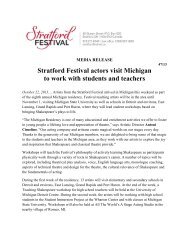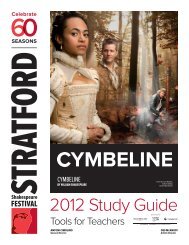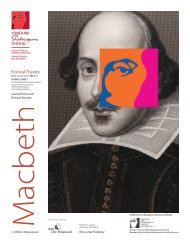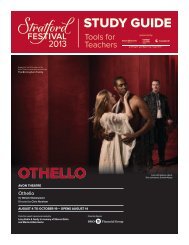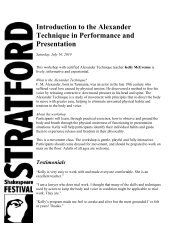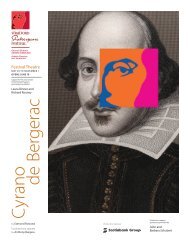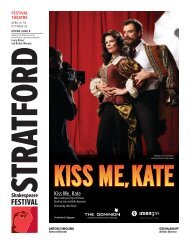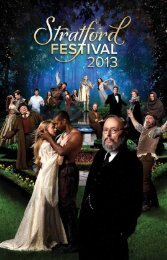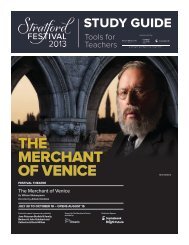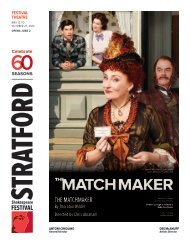Twelfth Night Study Guide - Stratford Festival
Twelfth Night Study Guide - Stratford Festival
Twelfth Night Study Guide - Stratford Festival
Create successful ePaper yourself
Turn your PDF publications into a flip-book with our unique Google optimized e-Paper software.
Imaginative Ways to Approach the Text:<br />
Just a word<br />
Grade Level<br />
Ontario<br />
Curriculum<br />
Expectations<br />
Time Needed<br />
Space<br />
Materials<br />
all<br />
Listening to Understand<br />
Speaking to Communicate<br />
Drama: Creation<br />
One class period<br />
Clear space in the classroom for students to work in small groups<br />
Copies of Act 1, Scene 4 of <strong>Twelfth</strong> <strong>Night</strong> for all students<br />
Overview:<br />
This activity reduces the number of words in a scene to the bare essentials - usually one word<br />
for each speech. This activity is very helpful for: involving students who are not confident<br />
speaking large sections of Shakespeare’s text; getting at the “heart” of the scene; finding<br />
patterns in the language. By selecting words in this fashion and speaking chorally, students are<br />
highlighting meanings in the text.<br />
The exercise:<br />
Part 1<br />
Divide the students into groups of three and handout copies of Act 1, Scene 4 from<br />
<strong>Twelfth</strong> <strong>Night</strong>. Have them cast themselves as Valentine, Viola, and Orsino and read<br />
through the scene<br />
Next, ask the students to decide, with their playing partners, which words best tell the<br />
story of the scene. Generally, each speech/line by a character may be reduced to a<br />
single word. Groups will then rehearse this mini-scene using only the words chosen.<br />
Direct students to find a gesture for each word. Encourage students to make their<br />
movements as big and as specific as possible in order to clarify their interpretive choices.<br />
<br />
Part 2<br />
<br />
<br />
Have groups volunteer to present their version of the scene to the rest of the class.<br />
Discuss the variations in choices made by each group and how clearly the overall<br />
message of the scene is communicated though the use of these essential words and<br />
gesture.<br />
Divide the class into three groups. One group will be Valentine, one group will be<br />
Orsino, and one group will be Viola. Each group will elect a choral leader for the role.<br />
(The choral leader should be a student who is comfortable reading the full text of the<br />
scene for that character).<br />
The class will now enact the scene. The choral leaders will take on the parts of<br />
Valentine, Viola and Orsino with their individual choruses gathered behind them. The<br />
chorus echoes all the words spoken by their leader which they want to emphasize.<br />
These choices may be made spontaneously or may be planned in advance within these<br />
new groups based on their experience in smaller groups in part 1 and the discussion<br />
which ensued. Echoed words and gestures should occur immediately after the choral<br />
leader speaks them and before another word is spoken (either by the choral leader or<br />
another character).<br />
*adapted from an idea in the RSC Shakespeare Toolkit for Teachers.<br />
<strong>Twelfth</strong> <strong>Night</strong> <strong>Study</strong> <strong>Guide</strong><br />
<strong>Stratford</strong> Shakespeare <strong>Festival</strong> 2011<br />
13



